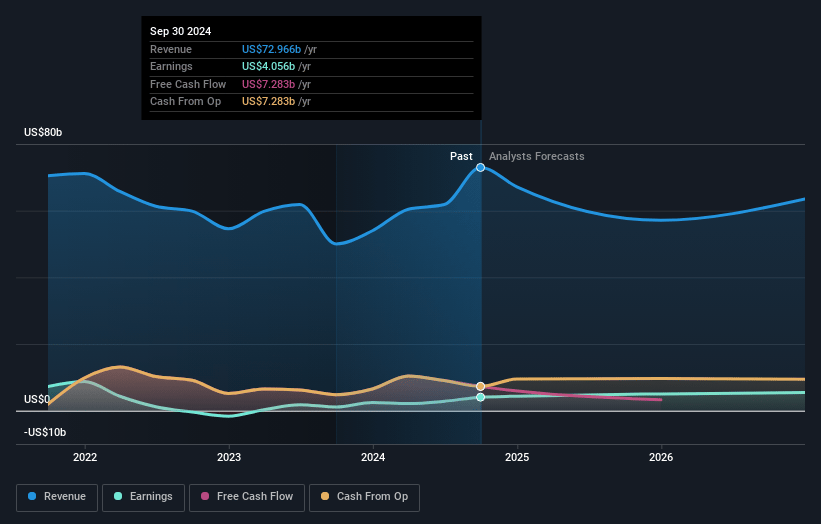Key Takeaways
- Strategic pivot to capital-efficient products and technology investments enhance earnings quality, net margins, and sustainable revenue growth.
- Global expansion into retirement markets, especially Japan, increases revenue potential and diversifies income streams.
- Exchange rate volatility, regulatory changes, and pension market competition pose risks to Prudential's earnings stability and international revenue growth, especially in Japan.
Catalysts
About Prudential Financial- Provides insurance, investment management, and other financial products and services in the United States and internationally.
- Prudential's strategic pivot to more capital-efficient products, such as reducing guaranteed universal life reserves by 60%, is expected to enhance earnings quality and support future growth. This strategy shift is likely to positively impact net margins.
- Significant opportunities for growth in the global retirement market, including leadership in pension risk transfer with deals like IBM’s $6 billion transaction, suggest increased revenue potential for Prudential's Retirement Strategies business.
- Expansion into new markets and product lines, especially in Japan with a 30% increase in retirement and savings product sales, could drive revenue growth and help diversify Prudential's income streams.
- The establishment of a dedicated team in Japan for Prismic indicates a focus on capturing reinsurance opportunities in the region, potentially increasing capital efficiency and freeing up resources for reinvestment and further growth.
- Investments in technology and strategic partnerships, such as those in the group insurance segment, are expected to enhance operational efficiency and customer experience, potentially leading to improved net margins and sustainable revenue growth.
Prudential Financial Future Earnings and Revenue Growth
Assumptions
How have these above catalysts been quantified?- Analysts are assuming Prudential Financial's revenue will decrease by -4.3% annually over the next 3 years.
- Analysts assume that profit margins will increase from 5.6% today to 7.7% in 3 years time.
- Analysts expect earnings to reach $4.9 billion (and earnings per share of $12.51) by about January 2028, up from $4.1 billion today. However, there is some disagreement amongst the analysts with the more bullish ones expecting earnings as high as $5.5 billion.
- In order for the above numbers to justify the analysts price target, the company would need to trade at a PE ratio of 12.5x on those 2028 earnings, up from 10.6x today. This future PE is lower than the current PE for the US Insurance industry at 12.8x.
- Analysts expect the number of shares outstanding to grow by 3.49% per year for the next 3 years.
- To value all of this in today's terms, we will use a discount rate of 7.55%, as per the Simply Wall St company report.
Prudential Financial Future Earnings Per Share Growth
Risks
What could happen that would invalidate this narrative?- The potential volatility in exchange rates, particularly with the yen, poses a risk of elevated product surrenders and earnings pressure, which could adversely impact Prudential's international revenue streams, particularly in Japan.
- The shift towards capital-efficient products and the potential impact of regulatory changes, such as the new economic solvency regime in Japan, could affect long-term profitability and necessitate strategic adjustments, impacting Prudential's earnings stability.
- Underlying earnings pressure due to continued investments and higher expenses in enterprise initiatives may dampen net margins if these investments do not result in the projected growth and efficiencies.
- While the pension risk transfer market presents opportunities, the highly competitive nature of this market requires strategic pricing and execution, which could impact Prudential's revenue growth and returns if not managed carefully.
- Uncertainties in the U.S. and international mortality trends, as suggested by external reports, could lead to adverse effects on underwriting results and prudential's earnings if mortality experience deviates significantly from assumptions.
Valuation
How have all the factors above been brought together to estimate a fair value?- The analysts have a consensus price target of $126.14 for Prudential Financial based on their expectations of its future earnings growth, profit margins and other risk factors. However, there is a degree of disagreement amongst analysts, with the most bullish reporting a price target of $149.0, and the most bearish reporting a price target of just $101.0.
- In order for you to agree with the analyst's consensus, you'd need to believe that by 2028, revenues will be $64.0 billion, earnings will come to $4.9 billion, and it would be trading on a PE ratio of 12.5x, assuming you use a discount rate of 7.5%.
- Given the current share price of $121.18, the analyst's price target of $126.14 is 3.9% higher. The relatively low difference between the current share price and the analyst consensus price target indicates that they believe on average, the company is fairly priced.
- We always encourage you to reach your own conclusions though. So sense check these analyst numbers against your own assumptions and expectations based on your understanding of the business and what you believe is probable.
How well do narratives help inform your perspective?
Disclaimer
Warren A.I. is a tool utilizing a Large Language Model (LLM) that ingests data on consensus price targets, forecasted revenue and earnings figures, as well as the transcripts of earnings calls to produce qualitative analysis. The narratives produced by Warren A.I. are general in nature and are based solely on analyst data and publicly-available material published by the respective companies. These scenarios are not indicative of the company's future performance and are exploratory in nature. Simply Wall St has no position in the company(s) mentioned. The price targets and estimates used are consensus data, and do not constitute a recommendation to buy or sell any stock, and they do not take account of your objectives, or your financial situation. Note that Warren A.I.'s analysis may not factor in the latest price-sensitive company announcements or qualitative material.
Read more narratives
There are no other narratives for this company.
View all narratives



